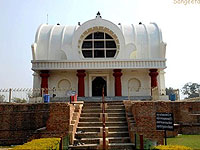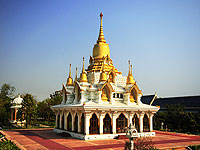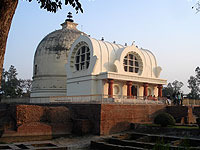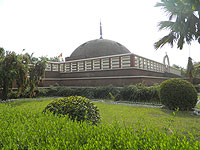| |
|
| |
Wild Desert Resort |
|
|
|
|
|
|
| |
 |
|
| |
| |
An Adventure on sand dunes and same. get a feel of shifting sand dunes Capturing the spirit of Sand Dunes and ensuring the perfect Dunes experience at Wild desert resort, a unique Sam Dunes Resort and Camp. |
|
|

|
|
|
|
|
|
|
| Kushinagar |
 The district of Kushinagar is named after the sacred death-place of Lord Buddha. At Kushinagar, Lord Buddha, an apostle of peace, comapassion and non-violence, attained Mahaparinirvana (Salvation) in 483 BC.
The district of Kushinagar is named after the sacred death-place of Lord Buddha. At Kushinagar, Lord Buddha, an apostle of peace, comapassion and non-violence, attained Mahaparinirvana (Salvation) in 483 BC.
History
The present Kushinagar is identified with Kushawati ( in pre- Buddha period ) and Kushinara (in Buddha period). Kushinara was the capital of Mallas which was one of the sixteen mahajanpads of the 6th Century B.C.
According to the Valmiki's Ramayana, the Mallas was earlier part of Kosala Janpad. Kushwati capital was built by Kush, son of Lord Ram, the hero of the famous epic, 'The Ramayan'. After Ram's renunciation of the world Kusa left Kusavati for Ayodhya. His cousin, ChandraKetu, son of Lakshman took possession of this region. As per Buddha Pali literature, Kushawati was named prior to the king Kush.  The naming of Kushwati was due to abundance of Kush grass found in this region which still holds good. Since then, it remained an integral part of the erstwhile empires of Maurya, Shunga, Kushana, Gupta and Harsha dynasties. The naming of Kushwati was due to abundance of Kush grass found in this region which still holds good. Since then, it remained an integral part of the erstwhile empires of Maurya, Shunga, Kushana, Gupta and Harsha dynasties.
In medieval period, Kushinagar had passed under the suzerainty of Kultury Kings. Kushinara continued to be a living city till the 12th Century A.D. and was thereafter lost into oblivion. Padrauna is believed to be ruled over by a Rajput adventurer, Madan Singh in the 15th century A.D.
However, modern Kushinagar came into prominence in the 19th Century with archeological excavations carried out by A.Cuningham, the first Archeological Surveyor of India and later Nirvana Statue of Lord Buddhafollowed by C.L. Carlleyle who exposed the main stupa and also discovered a 6.10 meters long statue of reclining Buddha, in 1876 A.D. Ven. Chandra Swami, a Burmeses Monk, came to India in 1903 and made "Mahaparinirvana Temple" into a living shrine.
After independence, Kushinagar remained the part of district Deoria. On 13th May, 1994, it came into being as a new district of Uttar Pradesh for an all round balanced and speedy development.
Cultural & Historical Importance
Kushinagar has its own cultural and historical importance.
It belongs to the Great Lord Buddha, founder of Buddhism, who delivered his last sermon, attained "Mahaparinirvana" and was cremated at Ramabhar (Kushinagar).Buddha's cremation was done at " Mukut Bandhan" (Ramabhar), where 'Mallas' constructed a big stupa over the ashes. Later, Ashoka, the great, had also renovated it. Chinese travellers, Fa Hien & Hieun Tsang have also mentioned " Kushinara " in their Travel-Memo.
It is also associated with Lord Mahavir, 24th tirthankar of Jain Sect, founder of Jainism. It is believed that Lord Mahavrir passed away or attained Parinirvana at Pawa. As per Pali Tripitak, Pawa was the second capital of the Mallas, the first being Kushinara. Pawa is now being identified with present day 'Fazilnagar', a place 16 kms south - east of Kushinagar.
 The district of Kushinagar had been witness to the glorious ancient history and culture. It is believed to be an important centre for Vaishnav, Shiv, Shaktipeeth, Buddha, Mahavir etc. Situtaed on the bank of river Gandak and nearerto the terai of the Himalayas, this region was an ideal 'Meditation Place' for sages, saints hermits and Mahatamas who were attracted by its pious. tranquil and charming natural surroundings. Archeological excavation has yielded rich collection of antiquities. Artistic artifacts and statues of various gods and goddesses.
The district of Kushinagar had been witness to the glorious ancient history and culture. It is believed to be an important centre for Vaishnav, Shiv, Shaktipeeth, Buddha, Mahavir etc. Situtaed on the bank of river Gandak and nearerto the terai of the Himalayas, this region was an ideal 'Meditation Place' for sages, saints hermits and Mahatamas who were attracted by its pious. tranquil and charming natural surroundings. Archeological excavation has yielded rich collection of antiquities. Artistic artifacts and statues of various gods and goddesses.
The significance of this region is also due to being ' Link - route ' of ancient highways. Among them were important highways Ayodhya - Janakpur (Bihar), Rajgrih - Vaishali - Shrawasti, Maharshi Valmiki's Ashram, Ashoka, the great Mauryas, Pillars routes, passing through this district.
|
|
|


